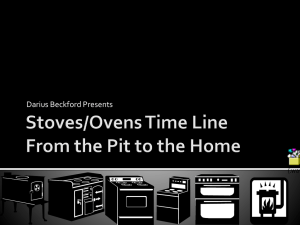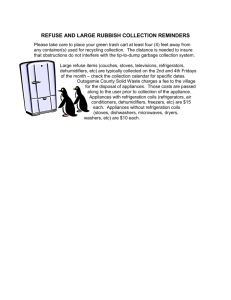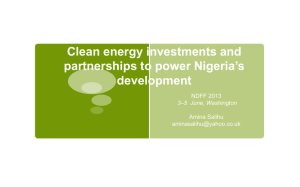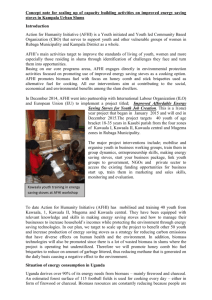Tanzania Case Study- Improved woodfuel saving stoves
advertisement
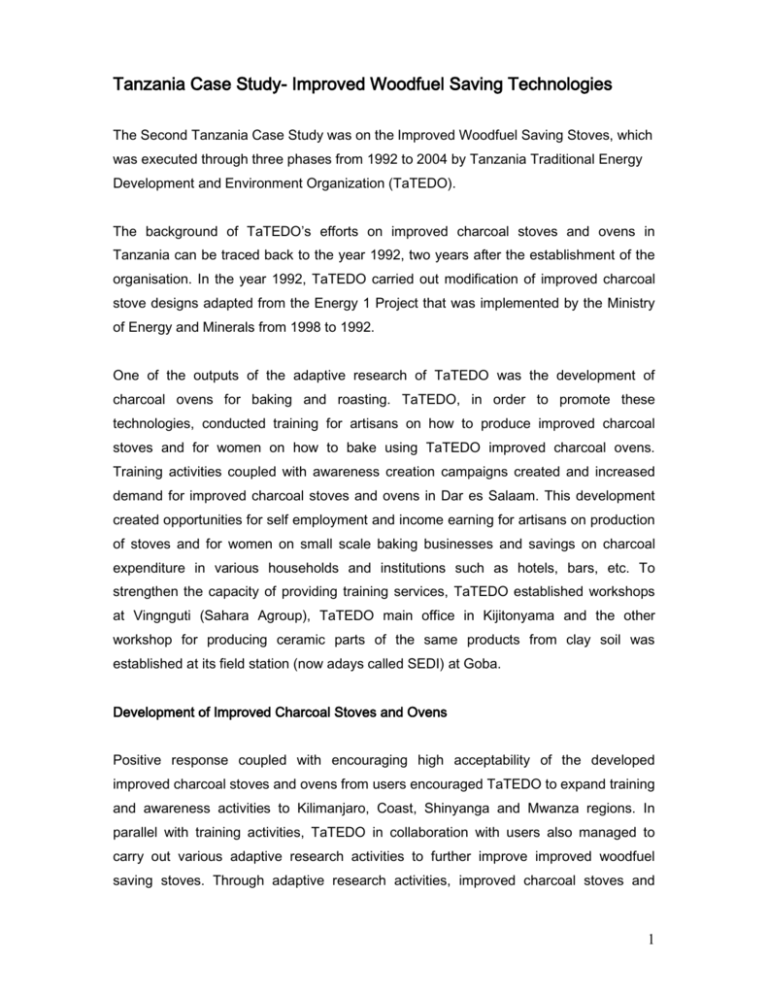
Tanzania Case Study- Improved Woodfuel Saving Technologies The Second Tanzania Case Study was on the Improved Woodfuel Saving Stoves, which was executed through three phases from 1992 to 2004 by Tanzania Traditional Energy Development and Environment Organization (TaTEDO). The background of TaTEDO’s efforts on improved charcoal stoves and ovens in Tanzania can be traced back to the year 1992, two years after the establishment of the organisation. In the year 1992, TaTEDO carried out modification of improved charcoal stove designs adapted from the Energy 1 Project that was implemented by the Ministry of Energy and Minerals from 1998 to 1992. One of the outputs of the adaptive research of TaTEDO was the development of charcoal ovens for baking and roasting. TaTEDO, in order to promote these technologies, conducted training for artisans on how to produce improved charcoal stoves and for women on how to bake using TaTEDO improved charcoal ovens. Training activities coupled with awareness creation campaigns created and increased demand for improved charcoal stoves and ovens in Dar es Salaam. This development created opportunities for self employment and income earning for artisans on production of stoves and for women on small scale baking businesses and savings on charcoal expenditure in various households and institutions such as hotels, bars, etc. To strengthen the capacity of providing training services, TaTEDO established workshops at Vingnguti (Sahara Agroup), TaTEDO main office in Kijitonyama and the other workshop for producing ceramic parts of the same products from clay soil was established at its field station (now adays called SEDI) at Goba. Development of Improved Charcoal Stoves and Ovens Positive response coupled with encouraging high acceptability of the developed improved charcoal stoves and ovens from users encouraged TaTEDO to expand training and awareness activities to Kilimanjaro, Coast, Shinyanga and Mwanza regions. In parallel with training activities, TaTEDO in collaboration with users also managed to carry out various adaptive research activities to further improve improved woodfuel saving stoves. Through adaptive research activities, improved charcoal stoves and 1 ovens were modified and adopted to suit the requirements of communities in the respective regions. This was made possible with generous financial support from HIVOS, EU and NORAD under the four-year (1999 – 2005) project on Integrated Renewable Energy Development and Environment Conservation in Tanzania. TaTEDO has managed to develop a total of 12 prototypes of stoves and 6 types of ovens. All these stoves and ovens have passed through different processes of development depending upon the requirements of users and technical specifications considered appropriate. The thermal efficiency of these stoves and ovens compared to the traditional ones has been raised from 15 percent of the traditional charcoal stoves to between 30 and 40 percent. This implies that improved stoves can save consumption of charcoal by 40 to 50 percent compared to traditional charcoal stoves. Large Scale Production and Commercialization of Improved Stoves and Ovens In the year 1998 with support from UNDP/GEF, TaTEDO conducted a study on factors, which were hindering wide scale adoption of improved stoves in Dar es Salaam. The study revealed that the demand of improved stoves had increased from 4,000 improved stoves per month in 1994 to 7,000 improved stoves per month in 1998, but the trained artisans in Dar es Salaam were able to meet only half of the estimated demand. More than 40 percent of the estimated demand originated from other regions, which are not covered by TaTEDO activities. The current supply of improved stoves in Dar es Salaam is estimated to be at 13,000 improved stoves per month and is still growing. The existence of high demand and low capital base created enabling environment for increased production of low quality stoves in the market. To address the problem of quality control and low commercialisation of improved stoves in the market and capital base improvement, TaTEDO introduced element of business and market development for improved woodfuel saving technologies (stoves and ovens ) to scale up commercialisation efforts through development of entrepreneurship. The energy entrepreneurship development intends to revamp commercial viability of improved charcoal stoves and ovens business and provide challenges to artisans/distributors producing/selling inferior stoves in the market. Commercial viability of the business is expected to attract financial institutions and credit support-providing organisation to extend credit and loan assistance schemes to small-scale entrepreneurs 2 involved in such businesses. The objective of this business was to produce and sell in large scale improved woodfuel saving technologies such as charcoal stoves, charcoal ovens, firewood stoves, firewood ovens, biowaste stoves, etc. Assessment of the Case Study The impact study was carried out in different stove production groups (workshops), households and business enterprises, which benefited from TaTEDO initiatives. The visits to the stove production groups and conductance of the questionnaire gave the opportunity to observe the production and to gather data about the bottlenecks straight from the producers for analysis. The following methods were used to collect data for this study. Secondary data consultation, to understand the issues and topics within the stove projects, to understand the role and activities of TaTEDO and to understand the bottlenecks and opportunities of Micro and Small Scale business enterprises. Field observations: Visits of producers to see the production processes and situations in the areas of production. Non-scheduled structured interviews, to get the answer straight for the producers. Meetings with TaTEDO staff, to get background information about different topics in the improved woodfuel saving stoves. The data collection tools and methods used to conduct this study include structured questionnaire, interviews, meetings which gathered information on trends of group production, supply, market, use in the households, schools and business enterprises, saving of wood fuels, type of stove preferred, etc. Interviews were conducted with stove business vendors (groups, stove outlets, etc) users (households, restaurants, baking groups, school cooks etc), social centres (health centres, schools, recreational places, etc). Interviews collected information, which is related to energy savings, health improvements, employments, income generation, revenues, etc. 3 There was random sampling of households but the exercise sampled both household using charcoal stoves in the city and ones using firewood stoves at the outskirts of the city. The sampling also considered different income levels. There were a limited choice of stove production groups, therefore all groups were visited to get information about their performance. Sources of Information Data from reports of former studies within the Improved charcoal stoves industry in Tanzania in order to find out what kind of problems and relations are commonly found within the informal stove production industry and what kind of solutions are recommended, or are implemented in other regions. Data and reports of activities strongly related to the production of improved charcoal stoves and ovens. To understand the informal sector and get ideas on how this sector is organized. Knowledge of improved stoves sector available within TaTEDO and to get more information on the causes and effects of the bottlenecks in the stove production industry and get ideas for solution development and Knowledge about production processes and production management. Data of the current situation, obtained through the non-scheduled structured interview in order to make an appropriate questionnaire on production and management, and to describe the structure of the businesses. While this type of interview is conducted, the answers to the questions came straight from the producers in different stove production groups. It also created to opportunity to visit the groups or workshops and observe the production processes. All these interviews and other data collection methods focused mostly on outcomes and impact of improved woodfuel saving stoves and ovens to the target population. 4 Assessment Framework Input Raw Materials (clay liners, metal sheets, etc), infrastructure and expertise, artisans Activities Capacity building, adaptive research, market development, production and sales Employment Output Energy Services Sectors Outcome Effects Impact Clay Liners Cooking Households Woodfuel saving Forest conservation Environnent Conservation MDG7) Woodfuel saving stoves and ovens Baking Roasting Businesses Social (Health and Education) Natural resources Time Saving Reduced indoor air pollution Money saving Reduced women drudgery Gender equality (MDG3) Reduced respiratory diseases the kitchen Health Improvement (MDG 4, 5, 6) Income generation Poverty Reduction (MDG1) The Causal Chain for Improved Woodfuel Saving Technologies in Tanzania 5 The Result of the Case Study During the study, it was observed that some households are still using open three stone stoves with low thermal efficiency of 7-10 percent. In the urban areas, some households are using metal charcoal stoves with low thermal efficiency of between 10-15 percent on average are widely used for cooking. All such low efficient stoves are commonly used in social centres (schools, dispensary, prisons, etc) and in small and medium enterprises (beer brewing, bread baking, food vending, etc). Only 45 percent of the households in Dar es Salaam are using improved woodfuel saving stoves and in the countryside, only 20 percent of households have adopted improved woodfuel saving stoves and ovens. The performance of intervention on improved woodfuel saving stoves can be assessed in terms of income generation and employment, monetary saving, time saving, forest conservation and health improvements. i. Income generation and Employment Production of improved woodfuel saving stoves has been one way of generating income and employment for trained artisans, village technicians and women and it is a business, which was appreciated and adopted by them. On the other hand, more than 600 small entrepreneurs have engaged in the production and selling of efficient woodfuel stoves. To energy related SMEs (food vending, beer brewing, baking, meat roasting, etc), use of improved fuelwood saving technologies decreased the energy input costs by 45% and move towards: Increased overall profitability, which means more income is earned to the entrepreneurs; Increased viability of the enterprise and subsequent more employment opportunities. ii. Monetary Savings Due to their high efficiencies, improved fuelwood saving technologies consume less wood simultaneously generating enough heat, and thus less money will be spent in purchasing woodfuels. Energy efficiency in SMEs is also desirable for financial reasons. Financial reasons focus on the profitability and potential growth of the enterprise through funds saved from efficient stoves. Furthermore, the monetary savings by using an improved charcoal stove can be divided in two parts, first the investment savings and second the fuel savings. Traditional charcoal stove has a lifetime of half a year; the stove has to be replaced 6 times during the lifetime of improved charcoal stove. The average price of a bag of charcoal is around Tshs. 20,000 and contains normally 30kg charcoal. Annual amount of charcoal used by a household with traditional charcoal stoves is 1080 kg (36 bags) a year. The amount is significantly lower for households using improved charcoal stoves, which is 370 kg (12.4 bags) a year. Annual fuel cost savings will be about Tshs. 118,000 per household. iii. Time Savings Women and children are the main suppliers of firewood accounting to 60% and 23% respectively; men account to 13% and house-keepers 4%. The average time and walking distance for fetching and transporting firewood in many areas is hours and 6 Kilometres respectively. This shows that household members, particularly women, invest a considerable amount of time and energy in searching firewood. This intervention has reduced time needed for cooking and fetching firewood by 45%. Time saving will be 6 achieved through an increased heat capacity of the stoves and thus the increased efficiency. The time gained can be spent for other family productive and social activities. iv. Forest Conservation The introducing improved woodfuel saving stoves and ovens has reduced quantity of woodfuel used in household, social centres and SMEs. A household using three stones stove consumes around 2880 kg/year of firewood. According to this study, through the use of improved firewood stove consumption is around 1728 kg/year/household, annual saving is around 1152kg/household (equivalent to more than 20 trees/year). Further, annual fuel consumption for traditional charcoal stove is around 1080kg/household while for improved charcoal stove is around 370kg/year/household (annual charcoal saving is 10kg/household which is equivalent to around 60 trees). It was observed that a household using improved charcoal stove would save about 71 bags of charcoal in three years (which is equivalent to over 1800 trees). v. Health Improvements A better burning process in improved stoves reduces the emission of smoke and associated toxic gases (e.g. Carbon monoxide, Hydrocarbons, Nitrous Oxides, Sulphur Oxides, etc). Due to low emission of harmful gases and heat through the wall, the stoves provide better health conditions to users and reduce the risk of burning. Another benefit of the improved insulation is reduction of undesired space heating in the kitchens. The quality air in the kitchen and households to make more people use more improved woodfuel saving technologies (stoves and ovens) thereby less exposure to indoor pollution and consequently reduced respiratory diseases. vi. Gender Equality Improvements Women are responsible for collection of woodfuels in rural and peri-urban areas. Although, some can be bought form the vendors but this is responsibility of women and children. The collection and use of fuel-wood are related with heavy and often lowproductive time-consuming work. For instance, the average time and walking distance for fetching and transporting firewood in many areas is 4 hours and 6 kilometres per day respectively. This shows most of women’s time is spent in searching firewood. Further more, women are exposed to health hazards from smoke and carbon dioxide and other poisonous gases, generated by using inferior stoves. Therefore, adoption of woodfuel saving stoves has minimized the frequencies of collecting woodfuels by less than 2 times per week. These stoves have also reduced the hazards of in-door air pollution by reducing smoke in the kitchens. 7 Summary of Development Impacts and the Link with MDGs for the Improved Woodfuel Saving Stoves in Tanzania Intervention Technology Sectors IREDEC Improved woodfuel saving technologies (stoves and ovens) Households Proposed link to MDGs in casual link given as impact Improved gender equality (MDG3) Improved health (MDG 4 and 5) Business Health (social sector) Education (social sector) Substantiation Remarks Reduced drudgery of women firewood collection in peri-urban areas. Reduce respiratory diseases 4-5 hours per day of firewood collection at average distance of 6 km Reduced respiratory diseases incidences in the households Reduced emissions of smoke and associated toxic gases Time saved is used in both economic and social activities Cutting household health costs Improved household and kitchen environment (MDG7) Poverty reduction (MDG1) Reduced indoor air pollution Household monetary saving Annual household fuel cost saving of Tshs 118,00 (around USD 100) The saved amount is very high for a poor family living below the poverty line of USD 1 per day Employment and Poverty reduction (MDG1) Improved gender equality (MDG3) Income generation Income from sales of stoves and baked/roasted foodstuffs Both men and women doing business together using woodfuel saving ovens Capital and entrepreneurial skills are still required. Men will help women in their businesses due to smoke free or tolerable places Improved health (MDG 4and 5) Reduced cases of respiratory diseases Reduced respiratory diseases incidences in the medical records Reduced Women and children mortality Poverty reduction (MDG1) Cutting budgets for buying firewood and charcoal for school cooking Reduced amount of woodfuels used in schools and frequency of collecting woodfuels by pupils Fuel expenditure reduced by 45 % Time saved used for studying and partly for other chores Good kitchen environment for school cooks Forest conservation due to reduced frequency of tree cutting Reduced rate of tree cutting by 1800 per household for three years Environment conservation (MDG7) Natural Resources Case study findings and link to MDGs Environment conservation (MDG7) Improved kitchen environment in the restaurants and pubs Saving charcoal bags from 36 to 12.4 per year Men can even stay in the kitchen and discuss family issues with their wives The cumulative effect of all households using stoves gives a good number of tree saved. 8 9

